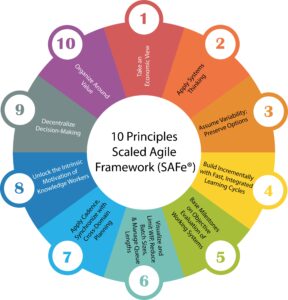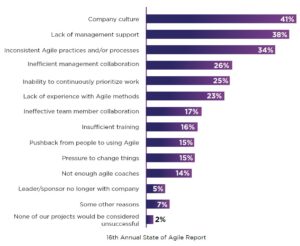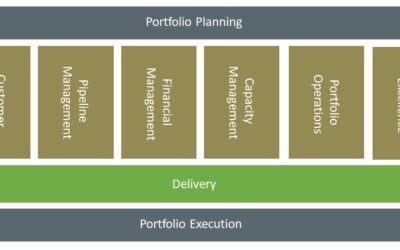Scaled Agile Framework – Guiding Principles of Enterprise Agility
 The Scaled Agile Framework (SAFe) provides a structured approach to scaling agile practices across an enterprise. It’s built on ten core principles guiding enterprises to scale lean and agile practices. These principles are an essential part of the mindset shift when applying SAFe practices in an organisation, to explore these in detail and understand how these principles are applied, consider joining our Leading SAFe training, where we go through real-time case studies from our clients. Here are those principles, along with brief descriptions:
The Scaled Agile Framework (SAFe) provides a structured approach to scaling agile practices across an enterprise. It’s built on ten core principles guiding enterprises to scale lean and agile practices. These principles are an essential part of the mindset shift when applying SAFe practices in an organisation, to explore these in detail and understand how these principles are applied, consider joining our Leading SAFe training, where we go through real-time case studies from our clients. Here are those principles, along with brief descriptions:
-
Take an Economic View
This principle emphasizes decision-making based on the economic impact. By understanding the economics of product development, organizations can make informed choices about what to build, when, and how much to invest. -
Apply Systems Thinking
Instead of looking at individual components or teams in isolation, this principle encourages a holistic approach. It stresses the importance of understanding how things interrelate and how a change in one component might affect others. -
Assume Variability; Preserve Options
Variability is a natural part of the development process. Instead of eliminating variability, SAFe promotes preserving multiple options as long as it is economically sensible. This provides flexibility to adjust to changing requirements or conditions. -
Build Incrementally with Fast, Integrated Learning Cycles
This principle is about delivering in small increments, enabling fast feedback and integrated learning. By doing so, enterprises can adjust their direction based on their learning, ensuring they consistently deliver maximum value. -
Base Milestones on Objective Evaluation of Working Systems
In SAFe, milestones are not based on documents or phase completions but on an objective evaluation of functioning systems. This ensures that at each major decision point, there’s a working, tested solution that meets the requirements. -
Visualize and Limit WIP, Reduce Batch Sizes, and Manage Queue Lengths
Scaled Agile Framework emphasizes visualizing work, limiting work-in-progress (WIP), delivering in small batch sizes, and managing queue lengths to enhance flow in the development process. This aids in quickly identifying and addressing issues, thereby enhancing efficiency. -
Apply Cadence, Synchronize with Cross-Domain Planning
Organizations can better manage dependencies by maintaining a steady, predictable cadence, synchronizing activities across different domains and ensuring that different system parts integrate smoothly. -
Unlock the Intrinsic Motivation of Knowledge Workers
People are at the heart of SAFe. By acknowledging their expertise and creating an environment where they can innovate, collaborate, and grow, enterprises can achieve better results and increased job satisfaction. -
Decentralize Decision-Making
While specific decisions must be made strategically, those with the most knowledge about the situation best make many day-to-day decisions. By decentralizing decision-making, enterprises can be more agile and responsive. -
Organize Around Value
Instead of organizing around functions or projects, SAFe recommends organizing around value streams. This ensures that efforts are always aligned with delivering customer value, streamlining processes, and reducing waste.
Why bother about these principles?
One might wonder, “With the 12 foundational principles from the Agile Manifesto, do we truly need another set of principles for our Agile transformation?” It’s a valid question, so let’s delve deeper into this.
The architects behind the Scaled Agile Framework recognize the bedrock they’ve built: the traditional lean agile principles. Moreover, they credit the myriad insights provided by pioneers in the Agile realm.
But times have changed. Two decades back, the landscape of software development was considerably different. Distributed teams working across global boundaries weren’t as prevalent as today. Our present-day organizations have not only grown in size but have also evolved in terms of complexity and operational sophistication.
SAFe, understanding these shifts, endeavoured to distil the foundational knowledge from the past, amalgamating it with the insights gleaned from countless practical implementations. It’s an evolution, a natural progression, to fit the demands of the modern enterprise.
Still, it’s essential to recognize that SAFe doesn’t claim to be a one-size-fits-all solution. As organizations scale their Agile practices, they’ll encounter challenges unique to their milieu. This is where the ten underlying principles come into play. Think of them as a compass – guiding teams even when they’re treading uncharted waters, ensuring they remain true to the ultimate aim of the House of Lean: delivering maximum value promptly, without compromising on quality, all the while enriching both individuals and the broader community.
 In essence, these principles aren’t just an ‘add-on’ but a recalibration, keeping the evolving needs of enterprises in focus. We have helped many organisations adapt to these values and principles, enabling the cultural shift required to grow and yield benefits from these practices. According to the 16th Annual State of Agile Report, Culture was the biggest challenge while adopting agile practices at the organisational level. Contact us for a confidential conversation on your needs and how we can assist in your agile journey.
In essence, these principles aren’t just an ‘add-on’ but a recalibration, keeping the evolving needs of enterprises in focus. We have helped many organisations adapt to these values and principles, enabling the cultural shift required to grow and yield benefits from these practices. According to the 16th Annual State of Agile Report, Culture was the biggest challenge while adopting agile practices at the organisational level. Contact us for a confidential conversation on your needs and how we can assist in your agile journey.
When these principles are correctly applied, enterprises can achieve enhanced agility, faster delivery of value, and improved collaboration across teams and departments. They form the foundation of SAFe’s approach to scaling agile practices across large organizations.

